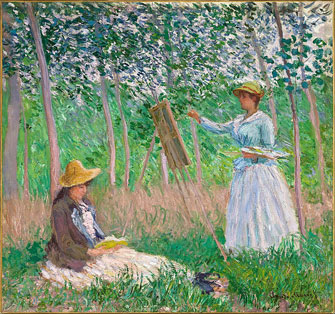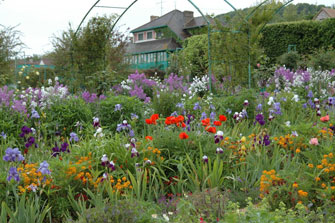Furnishing Giverny for
Its Former Residents

“In the Woods at Giverny: Blanche Hoschedé at Her Easel with Suzanne Hoschedé Reading” (1887), by Claude Monet.
As is by now well-known, the artist Claude Monet and his family moved into a house in the village of Giverny, near Rouen, in 1883. He lived there until his death in 1926 and over the years created the garden in which he painted some of his most famous works. Now run by the Fondation Claude Monet Giverny, the house and garden are open to the public from April 1 to November 1.
The Monet estate has been undergoing a gradual renovation in recent years. Last year, Monet’s bedroom was restored, and now the bedroom of the artist’s stepdaughter, Blanche Hoschedé-Monet, has been opened to the public after a total refurbishment by the interior decorator Hubert Le Gall.
Unable to find photographs or literature to give a clue to the actual appearance of the room, Gall chose Japanese-style floral wallpaper and curtains in the taste of the period to create a delightfully feminine room inspired by interiors painted by Monet’s friend, the painter Edouard Vuillard.
The restoration of Blanche’s room adds another level of emotional resonance to Monet’s house, given that the two had a complex, intimate and long-lasting relationship.
One of the six children of Monet’s wealthy patrons, Ernest and Alice Hoschedé, Blanche first met Monet in 1876, when she was just 11 years old. She later remembered him at this time as a playful, teasing man.
Three years later, Monet’s first wife, Camille, died of tuberculosis, while Hoschedé went bankrupt and his marriage collapsed. Monet then married Alice and the re-combined families set up housekeeping at Giverny.
By the age of 17, Blanche was painting with Monet and accompanying him on expeditions in the neighborhood. Three canvases by Monet dating from 1887 immortalize her in the act of painting while her sister Suzanne reads.
Then, in 1897, to everyone’s surprise, Blanche married Jean, Monet’s eldest son by his first wife. The couple lived for a while in Rouen, where Jean worked as a chemist, before returning to Giverny, where they moved into a small house Monet bought for them.
Alice died in 1911 and Jean three years later, whereupon Blanche moved back into the family home, taking her mother’s place in the household by officiating over the rituals of its famous dinners and devoting herself entirely to the well-being of her aging father-in-law.
According to Gustave Geffroy, a family friend and Monet’s first biographer, the artist was only able to continue his work thanks to her love and devotion.
After his death, Blanche continued to live in the house and maintained the garden until World War II, when the hardships of the German occupation forced her to abandon it. She died in Nice in 1947.
The garden that was such a large part of Blanche’s life is also being restored over the years to approximate as closely as possible the way it was in Monet’s time. Each season offers

Monet’s house and part of the garden. © F. Didillon
unique visual experience as the flowers and plants cycle through an extraordinary palette of colors, one more breathtaking than the next.
Late April is the tulip season, with every imaginable color and variety on show in serried ranks in the upper garden’s flower beds, interspersed with alleyways edged by espaliered apple trees that fill the air with the scent of their blossoms.
More spectacular still is the lower garden, reached through a brightly painted tunnel beneath the road to the village. Here a water garden is fed by a clear stream, its water-lily ponds flanked by purple and red flowering azaleas. Hyacinths abound, and an island planted with bamboo is reached by painted Japanese-style wooden bridges.
The garden that inspired Monet’s paintings is being re-created based on what can be seen in those paintings. Monet created his garden in the same way he painted, according to James Priest, head gardener since 2011, who sees it as his job “to translate the different atmospheres of the light while respecting the harmony and coherence of Monet’s painting.”
Fondation Claude Monet Giverny: 84, rue Claude Monet, 27620 Giverny. Tel.: 02 32 51 28 21. Open daily, April 1-November 1, 9:30am-6pm. Click here for info on getting there. An online reservation is advisable. www.fondation-monet.com
Click here to read all of this week’s new articles on the Paris Update home page.
Reader Reaction: Click here to respond to this article (your response may be published on this page and is subject to editing).
Support Paris Update by ordering books from Paris Update’s Amazon store at no extra cost. Click on your preferred Amazon location: U.K., France, U.S.
© 2014 Paris Update
Favorite